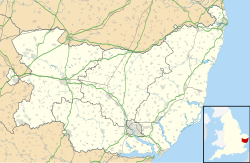Top Qs
Timeline
Chat
Perspective
Santon Downham
Village in Suffolk, England From Wikipedia, the free encyclopedia
Remove ads
Santon Downham is a village and civil parish in the West Suffolk district of Suffolk in eastern England. In 2005 it had a population of 240.[2] The village is located within Thetford Forest on a meander of the River Little Ouse on the Norfolk-Suffolk border. Thetford is 4 miles (6 km) southeast and the nearest railway station is in Brandon 2 miles (3 km) west.
Remove ads
History

The village was the administrative centre for the Eastern Forestry Commission for many years, following the planting of tens of thousands of trees in the Breckland to form the Thetford Forest. The District office and staff were housed in a 1960s office building close to the site of the now-demolished Downham Hall. The Hall garden formed the base for the nursery department of the district. The Forestry Commission repair depot was built close by in an award-winning building, next to which stood the Forestry Commission fire station. A Bedford 'Green Goddess' fire tender and a water tanker were kept in the fire station due to the high fire risk in the area.
In 1972 the bridge over the River Little Ouse appeared in programme 50 of the fifth series of BBC's sitcom Dad's Army, when Captain Mainwaring and his troops attempt to demolish it.[3][4]
Remove ads
Climate
Summarize
Perspective
Santon Downham has an oceanic climate (Köppen: Cfb).
The highest temperature since records began in 1959 was 39.0 °C (102.2 °F) on 19 July 2022 and the lowest was −18.9 °C (−2.0 °F) on 23 January 1963.[7]
Santon Downham is a known frost hollow and on 1 and 3 June 1962 it recorded the UK's lowest June temperature on record with −5.6 °C (21.9 °F), a record it also shares with Dalwhinnie in the highlands of Scotland.[8] The temperature can go below freezing at any time of the year.
Remove ads
Transport
The Santon Downham Tramway was a 6-kilometre (3.7 mi) long narrow-gauge railway, which was operated around 1918 to 1922.
See also
References
External links
Wikiwand - on
Seamless Wikipedia browsing. On steroids.
Remove ads


